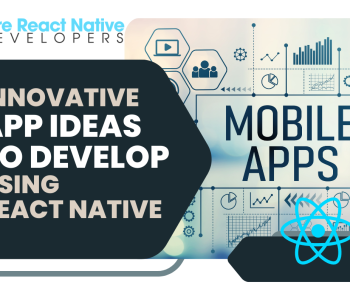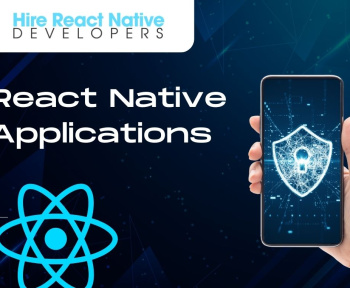The market for developing mobile applications is thriving and becoming more mature by the day. According to Statista, there are over 3.5+ million apps on Google Play Store whereas the App Store has 1.6+ million apps available.
At a glance, developing a React Native app may seem to have only two major reasons: creating an app for the Google Play Store using Android or for the App Store with iOS. And that’s true for a long time.
However, there is now a third – making cross-platform applications. In such cases, it is better to choose this strategy for creating several platform applications rather than another mobile development framework called React Native.
In addition to this POST showing how it works and what benefits you can get from using React Native while developing mobile apps
What Is React Mobile App Development?
The market for React native app examples that can be used on various platforms is anticipated to reach $364.54 billion by 2028, according to Verified Market Research. This great leap is facilitated by the progressive technology used in developing mobile applications, with React being one of such tools in this specific category.
Facebook released the first version of React as an open-source JavaScript framework for creating native mobile applications in 2013. At its core, the React family has two components: ReactJS and React Native.
What is React Native?
In 2015, the second version came out. This framework enables the creation of native apps for iOS and Android using React Native. Using familiar JavaScript and React principles, React Native permits you to build native mobile applications for iOS as well as android.
You can think of it as being React for your phone! What this means is that you will write reusable components that map to native UI elements so that your app feels like it is running on a particular platform.
Because of this “write once, run anywhere” philosophy, you will be able to save time and effort while creating great features rather than learning multiple languages. As such, if you are not interested in Java or Swift when creating amazing mobile apps, then React Native could just be the right match for you.
Important Features Of React Native
Finding experts in React itself, iOS or Android among React Native developers may be challenging. However, if you know some key elements of the React Native mobile app development framework it will be a bit easier. So, without further ado, let’s get into the most important parts and features that form mobile applications made with the help of React Native.
1. Components
Each individual app belonging to React Native has these building block elements. Codes are broken down into reusable units referred to as components which are then arranged by their corresponding logic. Mostly every react application consists of distinct components which might either be functional or class-based.
2. One-Way Data Binding
This important feature connects a certain data component with a user interface component. It only moves in one direction to increase app control. In other words, a single change should not affect the code of an application due to one-way data binding.
3. JavaScript XML
This new feature has directly extended the JavaScript syntax. Developers use JavaScript XML to “teach” React so that it appears and functions in specific ways for better use.
4.Virtual DOM
Components are based on HTML and represented structurally within the DOM. These improvements reflect all changes made in the application. When updating the program without a hitch, the OS compares its new version with an old one.
These components form the basis of React Native, ensuring that apps developed with this framework will be responsive and give users the best experience possible.
Advantages Of React Native
Developing a mobile application in React Native is considered very effective. It has a very light and responsive user interface (UI) yet reducing load time. React Native is also faster and more cost-effective for creating apps compared to native app development, without sacrificing better features, higher quality, modern functionality. These are some benefits of React native. Keep reading.
1. Platform Independent Functionality
Build cross-platform Android and iOS applications with React Native. With this technology, businesses can build Android and iOS apps from one code set hence saving much of their time. This approach cuts both the development time and cost by 50% when compared to traditional methods used for developing react native apps.
2. Code Reusability:
React Native facilitates code reuse by using a single codebase for both Android and iOS applications, which saves app developers from maintaining two different codebases for each platform. This can make the process of development much easier and cheaper than ever before, because instead of copying the same codes on various platforms people should consider main functions and logic of their applications.
3. Performance of native apps:
React Native apps perform just like the native ones written in Java or Swift even though it is cross-platform. To achieve this purpose, there are platform-specific components with native modules that utilize features of the underlying mobile operating systems. Consequently, users feel as if they are interacting with other types of similar software products; there is no difference between them and React Native applications developed natively leading to seamless user experience.
4. Hot Reloading:
Hot reloading is the feature of React Native that enables this so that just code changes are necessary without restarting your app. This is called hot reload, it speeds up development with immediate feedback and rapid iterations (hot reload). It can be very advantageous for those applications which have many UI elements because they can avoid waiting time after making minor changes in their applications (hot reload).
5. Larger Developer Community:
One of the reasons why React Native is so great is because it has a huge number of experienced developers who are part of its community (React Native). In this group, people support each other by providing solutions, answering questions, sharing experiences and even collaborating on projects that employ React Native among other things. But there’s more too! Many resources are available here as well!
Possible Concerns With React Mobile Development
Although there are many mobile React Native app development frameworks, none is superior to others. Before hiring a company to build your React Native mobile app, you should know what to look for. Despite having a big and active React community, Stack Overflow still has thousands of questions about React and similar frameworks. This might mean the documentation and instructions associated with using the framework could be better.
There is a potential drop in performance when using JavaScript in React. The gap between React and JavaScript makes apps made with React slower than Native ones. Thus, React Native is not suitable for applications with complex UIs. It may fail due to many moving parts and their related systems.
However, if you overlook these drawbacks, use react native as your framework when creating your mobile application. Nevertheless, it would be advisable to bear these problems in mind if there is any intention of improving the user interface.
ReactJS vs. React Native
ReactJS and React Native are the two most powerful forces in the world of web development. Still marketed as “React”, these two frameworks have taken different paths to serve distinct digital landscapes.
The unbeatable Lord of Websites, ReactJS enables interactive interfaces for single-page applications.
These could be dynamic dashboards, chat apps, or modern landing pages with smooth transitions and engaging experiences. To create such lightweight and high-performing components that are responsive to user interactions, ReactJS uses HTML, CSS, and JavaScript.
However, React Native is all about mobile. It makes native-looking apps using JavaScript and native APIs for both Android and iOS. These can be social media apps, e-commerce platforms while some even include complex games – wrapped in the guise of a platform-native feel but originating from an elegant single codebase.
| Feature | ReactJS | React Native |
| Platform | Web browsers | Android & iOS devices |
| Components | HTML-based | Platform-specific native components |
| Performance | Excellent rendering speed | Native-like performance |
| Cross-platform | Natively for web | Code reuse with platform-specific adaptations |
| Learning curve | Easier for web developers | Requires knowledge of native platforms |
It can, therefore, be concluded that ReactJS and React Native are powerful tools in the hands of professional developers. Realizing their benefits and constraints will help you design remarkable digital experiences for both web and mobile platforms.
Conclusion
Selecting React Native for developing apps is an astute choice based on its matchless benefits. Developers can make powerful applications easily and quickly using this framework which works on multiple platforms as well. It has a component-based architecture that allows the reuse of codes thereby making development more efficient.
Another advantage of React Native is that it gives an iOS or Android-like experience while using both platforms. It remains the leading platform in mobile app development with an active community, pre-built components library, and regular updates among other reasons. Finally, it balances well between performance, flexibility and fast production of excellent apps with many features.
Frequently Asked Questions (Faqs):
Yes! Some things make React Native outstanding when it comes to choosing a platform for developing an application; reusable codes, compatibility options, live reload functionality as well as third-party plugins.
Most companies see this framework as their number one tool when they want to build applications because they don’t need two teams: one doing iOS programming while another handles Android programming; instead just find experts who understand how this particular framework works on both devices simultaneously.
Both small and large-scale applications are suitable for React Native. Its scalability is due to its modular and component-based architecture, and several renowned companies have successfully used it, such as Facebook, Instagram and Airbnb.
React DevTools and Flipper are built-in debugging tools in React Native. Testers generally use Jest along with Detox for testing purposes. All these tools combined with React Native Debugger create a complete environment for debugging, testing, and profiling of React Native applications.
Absolutely! Existing native code that has been written in Swift, Objective-C or Java can be integrated into a React Native project. This comes in handy especially when you want to upgrade an existing native app with react native components or extend its functionality further. The framework provides “Native Modules” which act as bridges between native and react-native code.




